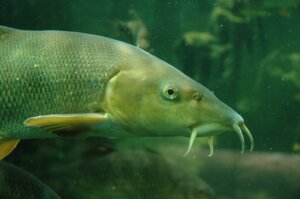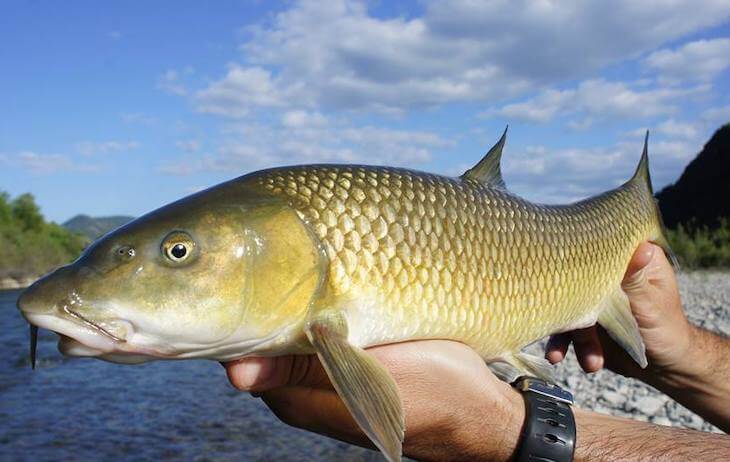The Barbel: Habitat, Characteristics and Curiosities


Written and verified by the psychologist Sara González Juárez
The barbel is a strong, robust freshwater fish that inhabits the rivers of Central Europe and is easily recognized by the 4 barbels near its mouth. Sadly, its swimming power and fierce character have motivated many anglers to hunt them excessively.
To get to know this species better, we’re going to characterize it in its natural environment, instead of focusing on its care in a home aquarium and for human amusement. So don’t miss anything as we’ll tell you all about the barbel in all its splendor.
Taxonomy and characteristics
The barbel, whose scientific name is Barbus barbus, is a freshwater fish easily recognizable by the feature that gives it its name, the 4 barbels found around its mouth. Belonging to the Cypriniformes order and the Cyprinidae family, it’s a member of the carp taxonomic group.
It’s an elongated, almost cylindrical fish with a flat belly. It can reach more than half a meter (1.6 feet) in length and almost 2.7 kilograms (6 lbs) in weight, depending on the habitat and food available in its environment. Although there are no striking features indicating sexual dimorphism, females are usually much larger than males.
Habitat of the barbel
The barbel is found in western and central European rivers from north of the Pyrenees to Russia and Lithuania. It has been artificially introduced into northern Italy and western England.
Most shoals of barbel live in fast-flowing water, where they move easily due to their powerful swimming ability and hydrodynamic morphology. These are usually clean water environments, with abundant oxygen and a gravel or rocky bottom, among which they find their food or shelter when they need to rest.
Food
The barbel is omnivorous and opportunistic, i.e. it feeds on whatever is within its reach. Even so, its diet consists mainly of worms, mollusks and larvae that hide under the river substrate. It also consumes plant matter that it finds around it, as well as eggs and larvae of other species.
Thanks to its barbels, it’s able to find them, as they’re very sensitive. It also uses them to remove small pebbles from the bottom, while larger stones are removed with the mouth.
Being able to withstand the strong current of the river bed gives them an advantage over other species, as competition for food is much lower.
Barbel behavior
It’s a diurnal fish (although it’s more active at dawn and dusk) and gregarious. It groups together in schools of variable size that usually never disintegrate, so it’s easy to see them all looking for food on the river bed, pushing pebbles aside with their mouths.
On the other hand, when the waters cool down in winter, their feeding stops, and they go into a lethargy that will last until spring. When doing so, they take refuge in the rocks at the bottom of the river, where other species have difficulty finding food.
Reproduction
When they awaken from hibernation, the breeding season begins in May-June, generally when the water temperature exceeds 15°C. They usually migrate to spawning grounds with fast-flowing water, where courtship begins. Females lead the way to the chosen site, followed by a long line of males who use tactics such as splashing, swimming alongside, or stealth fertilization of eggs.
This stealth fertilization is one of the most commonly used tactics. Up to 130 males may participate in a single spawning.
The female hits the gravel with her tail to clean it of silt and create a hole to deposit the eggs so they aren’t carried away by the current, and then covers them up again. A week later, the young hatch; they’ll remain in the gravel for several weeks, feeding on the yolk sac.
This is a slow-growing species, which doesn’t venture into the strong currents until it develops its musculature. Until then, they’ll feed on small invertebrates in the gravel.
Conservation status of the barbel

Thanks to its wide distribution, the barbel isn’t considered endangered at present and has therefore been given the status of Least Concern (LC). However, this doesn’t mean that they aren’t exempt from threats, such as river pollution or the introduction of foreign species such as catfish (Silurus glanis).
Modifications to the natural system also affect them, especially when the river course of is modified for water use.
Their numbers are rapidly declining in some areas, and conservation actions are practically non-existent. It’s possible that over the years this impressive fish will eventually disappear from the rivers if we aren’t able to protect it.
The barbel is a strong, robust freshwater fish that inhabits the rivers of Central Europe and is easily recognized by the 4 barbels near its mouth. Sadly, its swimming power and fierce character have motivated many anglers to hunt them excessively.
To get to know this species better, we’re going to characterize it in its natural environment, instead of focusing on its care in a home aquarium and for human amusement. So don’t miss anything as we’ll tell you all about the barbel in all its splendor.
Taxonomy and characteristics
The barbel, whose scientific name is Barbus barbus, is a freshwater fish easily recognizable by the feature that gives it its name, the 4 barbels found around its mouth. Belonging to the Cypriniformes order and the Cyprinidae family, it’s a member of the carp taxonomic group.
It’s an elongated, almost cylindrical fish with a flat belly. It can reach more than half a meter (1.6 feet) in length and almost 2.7 kilograms (6 lbs) in weight, depending on the habitat and food available in its environment. Although there are no striking features indicating sexual dimorphism, females are usually much larger than males.
Habitat of the barbel
The barbel is found in western and central European rivers from north of the Pyrenees to Russia and Lithuania. It has been artificially introduced into northern Italy and western England.
Most shoals of barbel live in fast-flowing water, where they move easily due to their powerful swimming ability and hydrodynamic morphology. These are usually clean water environments, with abundant oxygen and a gravel or rocky bottom, among which they find their food or shelter when they need to rest.
Food
The barbel is omnivorous and opportunistic, i.e. it feeds on whatever is within its reach. Even so, its diet consists mainly of worms, mollusks and larvae that hide under the river substrate. It also consumes plant matter that it finds around it, as well as eggs and larvae of other species.
Thanks to its barbels, it’s able to find them, as they’re very sensitive. It also uses them to remove small pebbles from the bottom, while larger stones are removed with the mouth.
Being able to withstand the strong current of the river bed gives them an advantage over other species, as competition for food is much lower.
Barbel behavior
It’s a diurnal fish (although it’s more active at dawn and dusk) and gregarious. It groups together in schools of variable size that usually never disintegrate, so it’s easy to see them all looking for food on the river bed, pushing pebbles aside with their mouths.
On the other hand, when the waters cool down in winter, their feeding stops, and they go into a lethargy that will last until spring. When doing so, they take refuge in the rocks at the bottom of the river, where other species have difficulty finding food.
Reproduction
When they awaken from hibernation, the breeding season begins in May-June, generally when the water temperature exceeds 15°C. They usually migrate to spawning grounds with fast-flowing water, where courtship begins. Females lead the way to the chosen site, followed by a long line of males who use tactics such as splashing, swimming alongside, or stealth fertilization of eggs.
This stealth fertilization is one of the most commonly used tactics. Up to 130 males may participate in a single spawning.
The female hits the gravel with her tail to clean it of silt and create a hole to deposit the eggs so they aren’t carried away by the current, and then covers them up again. A week later, the young hatch; they’ll remain in the gravel for several weeks, feeding on the yolk sac.
This is a slow-growing species, which doesn’t venture into the strong currents until it develops its musculature. Until then, they’ll feed on small invertebrates in the gravel.
Conservation status of the barbel

Thanks to its wide distribution, the barbel isn’t considered endangered at present and has therefore been given the status of Least Concern (LC). However, this doesn’t mean that they aren’t exempt from threats, such as river pollution or the introduction of foreign species such as catfish (Silurus glanis).
Modifications to the natural system also affect them, especially when the river course of is modified for water use.
Their numbers are rapidly declining in some areas, and conservation actions are practically non-existent. It’s possible that over the years this impressive fish will eventually disappear from the rivers if we aren’t able to protect it.
All cited sources were thoroughly reviewed by our team to ensure their quality, reliability, currency, and validity. The bibliography of this article was considered reliable and of academic or scientific accuracy.
- Freyhof, J. 2011. Barbus barbus (versión de errata publicada en 2016). La Lista Roja de Especies Amenazadas de la UICN 2011: e.T2561A97789324. https://dx.doi.org/10.2305/IUCN.UK.2011-1.RLTS.T2561A9454585.en . Consultado el 02 de enero de 2023 .
- Barbel – Encyclopedia of Life. (s. f.). https://eol.org/pages/211593
- Panchan, R., Pinter, K., Schmutz, S., & Unfer, G. (2022). Seasonal migration and habitat use of adult barbel (Barbus barbus) and nase (Chondrostoma nasus) along a river stretch of the Austrian Danube River. Environmental Biology of Fishes, 105(11), 1601-1616.
- Lucas, M. C., & Batley, E. (1996). Seasonal movements and behaviour of adult barbel Barbus barbus, a riverine cyprinid fish: implications for river management. Journal of Applied Ecology, 1345-1358.
This text is provided for informational purposes only and does not replace consultation with a professional. If in doubt, consult your specialist.








